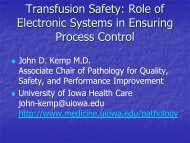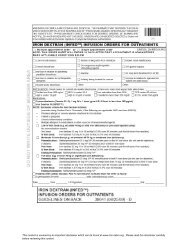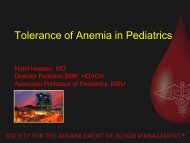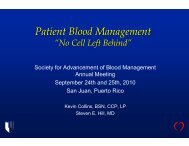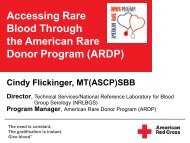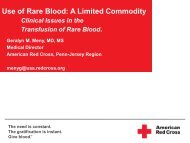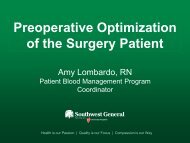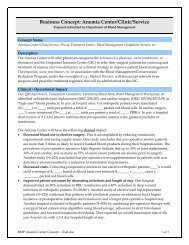Business Plan Expansion - Example A - SABM - Patient Blood ...
Business Plan Expansion - Example A - SABM - Patient Blood ...
Business Plan Expansion - Example A - SABM - Patient Blood ...
Create successful ePaper yourself
Turn your PDF publications into a flip-book with our unique Google optimized e-Paper software.
<strong>Business</strong> <strong>Plan</strong> / Unit Assessment<br />
(Expanding an existing blood management program)<br />
<strong>Example</strong> A<br />
General Information<br />
Director:<br />
Phone:<br />
E-mail:<br />
Department: e.g., <strong>Blood</strong>less, <strong>Blood</strong> Conservation, Transfusion-Free Services, etc.<br />
Cost Center:<br />
Internal Assessment<br />
1. General Description / Inventory of Services<br />
Your current program name here, e.g., <strong>Blood</strong>less Medical Program is a unique and profitable service line evolving from a<br />
program designed to attract and deliver medical/surgical care to patients seeking transfusion-avoidance, to a clinical<br />
approach that is desirable for all patients. Multiple cases performed without blood transfusion have been achieved in<br />
complex open heart, spine reconstruction, joint replacement and solid organ transplants surgeries. Thus, we propose<br />
expansion of our current program to a comprehensive <strong>Blood</strong> Management Program (BMP) that will serve all patients<br />
with the application of multiple blood conservation strategies in the pre, intra, and post-operative care.<br />
Subsequently, we believe this will improve (and reduce) blood utilization in several hospital service lines.<br />
<strong>Blood</strong> Management Programs are emerging as a:<br />
1) Primary goal for physicians because of increasing awareness of the limited clinical efficacy of blood therapy<br />
2) Structural solution for improving blood management because of dwindling inventories and rising costs of blood<br />
products<br />
Current Transfusion-free Medicine and Surgery (TFMS) services include:<br />
Promoting community awareness of blood conservation technology & transfusion alternatives<br />
Promoting physician education in blood conservation technology<br />
Referring patients to participating TFMS physicians<br />
Broadening application of TFMS technology to improve patient care hospital-wide<br />
Providing clinical support to physician requests for consultations<br />
Improving blood utilization and blood reduction in targeted service lines<br />
Providing patient data for research on efficacy of blood conservation technology<br />
2. Activity Statistics<br />
A ______ to ______ % annual increase in TFMS patient<br />
admissions includes:<br />
Inpatient Surgeries (IPS)<br />
Medical Admits (MA)<br />
Outpatient Surgery (OPS)<br />
Ancillary visits, e.g., Medical Imaging, Outpatient Treatment<br />
Center, Infusion Center/Anemia Center/Clinic, Special<br />
Procedures, etc.<br />
Beginning in year, physician requests for blood/anemia<br />
management consultations have increased by _____%.<br />
600<br />
500<br />
400<br />
300<br />
200<br />
100<br />
0<br />
2000 2001 2002 2003<br />
Inpatient Admissions<br />
IPS/MA/OPS<br />
Ancillary Visits<br />
BMP <strong>Business</strong> <strong>Plan</strong> <strong>Expansion</strong> <strong>Example</strong> A-final.doc 1 of 4
3. <strong>Patient</strong> Origin / Referrals<br />
• Our your hospital department name receives statewide phone/mail requests from patients seeking physician<br />
referrals.<br />
o <strong>Patient</strong> guidance in selecting insurance plans with access to your hospital name<br />
o HMO patients are directed to your hospital name Primary-Care Providers<br />
o Direct patient referrals to participating physicians represent ________% “new” business for hospital name<br />
• Physician requests for patient consultations & follow-up coordination for Anemia Center/Clinic/Infusion Room<br />
4. SWOT – Strengths<br />
<br />
<br />
<br />
<br />
<br />
<br />
<br />
<br />
Well-established TFMS program for number of years<br />
Recognized in, e.g., newspaper, television, radio, examples here for clinical excellence, innovation, advancements<br />
Experienced core TFMS physician team; physician champions<br />
Trained nursing staff, e.g., operating room, Infusion Center<br />
Developed and implemented blood conservation clinical protocols<br />
Fully operational Pre-operative Treatment Center, e.g., Anemia Center/Clinic, Infusion Center, <strong>Blood</strong><br />
Management Outpatient Service, etc.<br />
Prime location in city offering type of care: tertiary, quaternary care, etc. with broad range of services<br />
Active research staff seeking research opportunities for evaluating outcomes<br />
5. SWOT – Weaknesses<br />
<br />
<br />
<br />
<br />
<br />
<br />
<br />
<br />
Current TFMS program perceived by some medical staff as exclusive to religious sector<br />
Primarily patient-driven<br />
Under-developed educational tools<br />
Large hospital; not all service lines with expertise or motivation, e.g., BMT/Liver transplant<br />
Uncertainty of general public appeal for patient blood management<br />
Inner-city hospital; private versus semi-private rooms, etc.<br />
HMO restrictions<br />
<strong>Patient</strong> <strong>Blood</strong> Management perceived by some physicians as “too much work”<br />
6. SWOT – Opportunities<br />
<br />
<br />
<br />
<br />
<br />
<br />
<br />
<br />
Educate public about limitations of blood therapy and the need to conserve this finite resource<br />
Broaden BMP education to general public, managed care, physician office staff, and employees to increase<br />
market share and surgical patient admissions<br />
Reduce reliance on declining blood inventories and rising blood costs; current hard cost estimate by <strong>Blood</strong> Bank<br />
is $________ PRBC unit<br />
Evaluate and improve blood utilization/appropriate reduction<br />
Emerging medical evidence questioning perfusion benefits and over-utilization of blood products<br />
Optimizing blood management prior to hospitalization; promotion to surgeons, e.g., Infusion Center, Anemia<br />
Center/Clinic, etc.<br />
Transition blood management from patient-driven (TFMS) to physician-driven (BMP) in targeted service lines,<br />
e.g., Phase 1: CV Surgery; Phase 2: Orthopedic Surgery; Phase 3: Critical Care<br />
Accelerate BMP curriculum in Residency programs<br />
7. SWOT – Threats<br />
<br />
<br />
<br />
<br />
Independent expansion of TFMS programs to other hospitals vying for finite TFMS patient base<br />
Physicians replicating protocols at other hospitals, redirecting referred TFMS patients to other institutions<br />
Equipment and technology readily available at most hospitals<br />
Perception by misinformed medical staff that blood is cheap & BMP is expensive<br />
BMP <strong>Business</strong> <strong>Plan</strong> <strong>Expansion</strong> <strong>Example</strong> A-final.doc 2 of 4
8. Competitor Inventory<br />
<br />
<br />
<br />
External Assessment<br />
Hospital competitor name here is seeking, e.g., FTE or Physician to develop a BMP, but financial, clinical, and<br />
operational benefits and objectives are poorly defined<br />
Hospital competitor name here advertising TFMS surgery to attract patients and capitalize on our successes; could<br />
reduce TFMS patient admissions<br />
Hospital within your own system is seeking to hire FTE with experience; weakness will be primary focus on blood<br />
use reduction—could be self-limiting once goal is achieved; need for greater consumer appeal; and to build a<br />
program that will serve as a referral source, thus keeping physicians engaged and motivated<br />
9. Demographics, Consumer / Workforce / Physician Trends<br />
<br />
<br />
Experienced blood management physician(s) relocating to name of medical center<br />
Surgery admissions diverted to physician-owned outpatient surgery centers<br />
10. Legislation / Reimbursement / Technology - Innovation Trends<br />
<br />
<br />
Emerging blood “substitutes” hemoglobin-based oxygen carriers and expectant FDA approval for use in trauma<br />
Recent FDA “black box” warnings, e.g., ESAs, Aprotinin<br />
11. Growth Ability (Internal)<br />
<br />
<br />
<br />
Valuation<br />
Proportionate to department staffing, e.g., administrative/clinical FTEs, Medical Staff participation<br />
Proportionate to scope of public knowledge and awareness of new approach to improving surgical outcomes<br />
Proportionate to medical staff education and acceptance of new insights gained from a BMP<br />
12. Growth Potential (External)<br />
<br />
<br />
<br />
<br />
Anticipate a sustained slower growth in TFMS patient activity<br />
Anticipate future losses in TFMS patient admissions due to hospital name hospital, e.g., hospital system expansion<br />
of blood management program name<br />
Prepare for greater public appeal (PBM) and explore for a new source of patient admissions (improved outcomes<br />
due to better patient preparation for surgery, e.g., Anemia Center or Infusion Center<br />
Predict the BMP to become physician-driven, standard-of-care<br />
13. Product Excellence<br />
<br />
<br />
<br />
Increasing physician endorsement of patient blood management protocols; seek more patient referrals<br />
Repeat customer/patient activity<br />
Industry support of education efforts, e.g., dinner programs, grand rounds programs, educational grants<br />
14. Service Line Synergy<br />
<br />
<br />
<br />
<br />
Increased admissions to ancillary services, e.g., Outpatient Treatment Center, Medical Imaging, Catheterization<br />
Labs; Interventional Radiology, Emergency Department, etc.<br />
Increased operating room admissions<br />
Increased referrals to Family Practice, Internal Medicine, and OB/GYN clinics<br />
Pre-op Clinic/Anemia Center with enhanced surgical outcomes in Bariatric Surgery<br />
15. Strategic Fit<br />
<br />
Highly specialized – enhances existing and established services, e.g., high-risk obstetrics, solid organ, bone<br />
marrow transplants that draw patients from county, state, and country<br />
BMP <strong>Business</strong> <strong>Plan</strong> <strong>Expansion</strong> <strong>Example</strong> A-final.doc 3 of 4
Research and technology – supports the development and success of highly specialized services by playing a<br />
major role in the research community; acquisition of state-of-the art technology<br />
Teaching<br />
• Leverages patient blood management education to build and maintain cutting edge expertise; recruit<br />
and retain high-quality physicians, nurses and other healthcare professionals; and support highly<br />
specialized programs<br />
• Export medical education programs throughout region here via telemedicine; maintain the academic<br />
partnership with name) University; and refine nursing and allied education tracks that bring staff to your<br />
hospital name for training; and relocation of staff to other your hospital system facilities<br />
16. Financial Performance<br />
<br />
<br />
<br />
<br />
<br />
<br />
A _______ % to _______ % annual increase in, e.g., billing charges<br />
reflects increased, e.g., patient admissions, surgical volumes, etc.<br />
Attach report by <strong>Patient</strong> Financial Services.<br />
Reduction in red blood cell use in, e.g., primary CABG surgery by<br />
___ % produced a savings of $______ for year.<br />
Reduced Length of Stay in, e.g., primary CABG by # days resulted<br />
in a savings of $_________. Attach report by Finance<br />
Department.<br />
Reduced allogenic usage by ____ % in DRG______. See attached<br />
report by, e.g., Transfusion Committee, Laboratory Department.<br />
Increased surgical volume by ___% due to increased TFMS<br />
patient admissions.<br />
Cumulative annual savings for year to hospital is $____________.<br />
<strong>Blood</strong> Conservation Program $$ Charges 00-03<br />
18,000,000<br />
16,000,000<br />
14,000,000<br />
12,000,000<br />
10,000,000<br />
8,000,000<br />
6,000,000<br />
4,000,000<br />
2,000,000<br />
0<br />
2000 2001 2002 2003<br />
17. Current Marketing/Promotion<br />
<br />
<br />
<br />
<br />
<br />
<br />
<br />
<br />
Developing educational brochures for medical professionals, e.g., Anemia Center protocol<br />
Distributing “<strong>Patient</strong> Guide to <strong>Patient</strong> <strong>Blood</strong> Management” educational brochures to public and physician offices<br />
Producing a bi-annual newsletter<br />
Holding Public Forums with guest speakers<br />
Maintaining mailing lists of public seminar attendees<br />
Holding update and progress meetings with community leaders<br />
Developing medical education programs, e.g., CME, dinner meetings, noon conference, Grand Rounds<br />
Conducting regular nursing staff in-services<br />
18. Potential/Future Marketing/Promotion<br />
<br />
<br />
<br />
<br />
<br />
<br />
<br />
<br />
Develop and update educational tools<br />
Develop video for in-house advertising to families and the public<br />
Promote <strong>Blood</strong> Management Program and the Anemia Center/Clinic to medical staff<br />
Conduct health fairs<br />
Enhance website for public and medical professionals<br />
Develop localized research projects for nurses and physicians that measure quality and improved patient<br />
outcomes, e.g., case reports, retrospective chart reviews<br />
Partner with Research Department to explore opportunities to participate in national blood management studies<br />
Capitalize on <strong>SABM</strong> (Society for the Advancement of <strong>Blood</strong> Management) educational opportunities at their<br />
annual meetings<br />
BMP <strong>Business</strong> <strong>Plan</strong> <strong>Expansion</strong> <strong>Example</strong> A-final.doc 4 of 4






